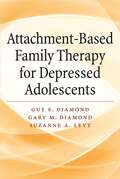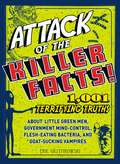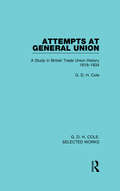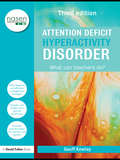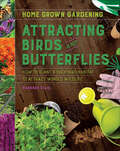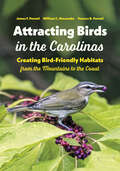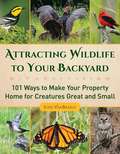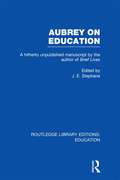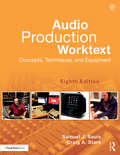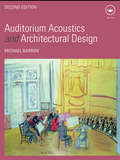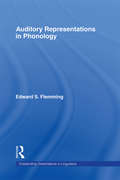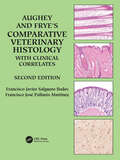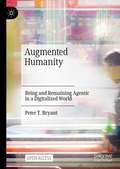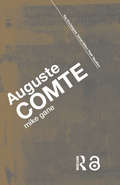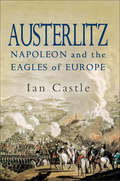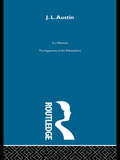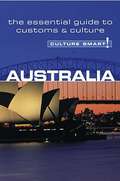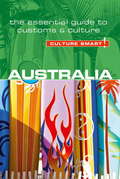- Table View
- List View
Attachment-Based Family Therapy for Depressed Adolescents
by Guy Diamond PhD Gary M. Diamond Suzanne A. LevyAttachment-Based Family Therapy (ABFT) is the only empirically supported family therapy model designed to treat adolescent depression. This book describes clinical strategies for therapists, as well as the theoretical basis of the approach and the evidence base that supports it. ABFT emerges from interpersonal theories that suggest adolescent depression and suicide can be precipitated, exacerbated, or buffered against by the quality of interpersonal relationships in families. ABFT aims to repair interpersonal ruptures and rebuild an emotionally protective, secure-based, parent–child relationship. The treatment initially focuses on repairing or strengthening attachment and then turns to promoting adolescent autonomy. In particular, the authors delineate five treatment phases, or "tasks," which each have distinct goals and strategies. Thus, while the model is trauma-focused and process-oriented, it includes a structure and a clear roadmap for facilitating the reparative process. The chapters blend empirical research with clinical guidance, illustrative vignettes, and a case study. With its unique emphasis on the depressed adolescent's need for attachment and autonomy, this book will show family therapists how to create in-session, corrective attachment experiences where adolescents seek — and parents provide — love and support.
Attack of the Killer Facts
by Eric GrzymkowskiFactoid Attack: Inherent sadistic streak in dentists confirmed!The electric chair was invented by a dentist, Dr. Alfred Southwick. Not surprising, dentists have been perfecting torture devices for centuries. Factoid Attack: Galaxy at risk! Intelligent life in short supply!In 1961, Astronomer Frank Drake estimated the number of probable intelligent civilizations inhabiting our galaxy. Using conservative numbers, that estimate came to 10,000. Unfortunately, we are not included in that total. Factoid Attack: Colorblind bulls hate all matadors equally!The color of a matador's cape, or muleta, is traditionally red, which is widely believed to irritate the bull. In reality, bulls are colorblind, so it is irrelevant what color cape a matador uses to antagonize them. Shot in the dark, but maybe it's the being stabbed with swords bit that pisses them off. Forget Fringe, Warehouse 13, and The X-Files. In this book, you'll find more weird and wacko truths than in all those combined. From golden poison dart frogs with enough venom to kill ten grown humans to cockroaches that can survive radiation 15 times stronger than what kills people, scary and strange just got scarier--and stranger!
Attack of the Killer Facts!
by Eric GryzymokowskiFactoid Attack: Inherent sadistic streak in dentists confirmed!The electric chair was invented by a dentist, Dr. Alfred Southwick. Not surprising, dentists have been perfecting torture devices for centuries. Factoid Attack: Galaxy at risk! Intelligent life in short supply!In 1961, Astronomer Frank Drake estimated the number of probable intelligent civilizations inhabiting our galaxy. Using conservative numbers, that estimate came to 10,000. Unfortunately, we are not included in that total.Factoid Attack: Colorblind bulls hate all matadors equally!The color of a matador's cape, or muleta, is traditionally red, which is widely believed to irritate the bull. In reality, bulls are colorblind, so it is irrelevant what color cape a matador uses to antagonize them. Shot in the dark, but maybe it's the being stabbed with swords bit that pisses them off.Forget Fringe, Warehouse 13, and The X-Files. In this book, you'll find more weird and wacko truths than in all those combined. From golden poison dart frogs with enough venom to kill ten grown humans to cockroaches that can survive radiation 15 times stronger than what kills people, scary and strange just got scarier--and stranger!
Attack of the Killer Facts!: 1,001 Terrifying Truths about the Little Green Men, Government Mind-Control, Flesh-Eating Bacteria, and Goat-Sucking Vampires
by Eric GryzymokowskiFactoid Attack: Inherent sadistic streak in dentists confirmed!The electric chair was invented by a dentist, Dr. Alfred Southwick. Not surprising, dentists have been perfecting torture devices for centuries.Factoid Attack: Galaxy at risk! Intelligent life in short supply!In 1961, Astronomer Frank Drake estimated the number of probable intelligent civilizations inhabiting our galaxy. Using conservative numbers, that estimate came to 10,000. Unfortunately, we are not included in that total.Factoid Attack: Colorblind bulls hate all matadors equally!The color of a matador's cape, or muleta, is traditionally red, which is widely believed to irritate the bull. In reality, bulls are colorblind, so it is irrelevant what color cape a matador uses to antagonize them. Shot in the dark, but maybe it's the being stabbed with swords bit that pisses them off.Forget Fringe, Warehouse 13, and The X-Files. In this book, you'll find more weird and wacko truths than in all those combined. From golden poison dart frogs with enough venom to kill ten grown humans to cockroaches that can survive radiation 15 times stronger than what kills people, scary and strange just got scarier-and stranger!
Attainable Sustainable: The Lost Art of Self-Reliant Living
by Kris BordessaPacked with delicious recipes, natural remedies, gardening tips, crafts, and more, this indispensable lifestyle reference from the popular blogger makes earth-friendly living fun.Whether you live in a city, suburb, or the country, this essential guide for the backyard homesteader will help you achieve a homespun life--from starting your own garden and pickling the food you grow to pressing wildflowers, baking sourdough loaves, quilting, raising chickens, and creating your own natural cleaning supplies. In these richly illustrated pages, sustainability-guru Kris Bordessa offers DIY lovers an indispensable home reference for sustainability in the 21st century, with tried-and-true advice, 50 enticing recipes, and step-by-step directions for creating easy, cost-efficient projects that will bring out your inner pioneer. Filled with 340 color photographs, this relatable, comprehensive book contains time honored-wisdom and modern know-how for getting back to basics in a beautiful, accessible package.
Attempts at General Union (Routledge Library Editions)
by G. D. H. ColeThis volume traces the attempts made after the Napoleonic Wars to link up all the numerous local and sectional Trade Societies into a single comprehensive ‘General Trades Union’ – attempts which culminated in the short-lived Grand National Consolidated Trades Union formed under Robert Owen’s influence in 1833. Based on materials not previously used by historians, this book throws new light on the development of Trade Unionism, particularly in the North of England, during these critical years.
Attention Deficit Hyperactivity Disorder: What Can Teachers Do? (nasen spotlight)
by Geoff KewleyIs Attention Deficit Hyperactivity Disorder a ‘made-up’ term? Is it simply an excuse for bad behaviour? How do children with ADHD really experience school? This practical teacher’s guide dispels all the myths and gets down to the facts about ADHD. It explores the nitty-gritty of what you need to know in order to help the children in your class to cope with this complex condition. This fully revised second edition gives an overview of the disorder based on the broad internationally recognised approach to ADHD, which takes account of its biological as well as environmental elements. It includes: real-life classroom scenarios and case studies of specific children; practical management strategies for both teachers and parents; an exploration of prevailing attitudes to ADHD; advice on initial diagnosis and ongoing assessment. Packed full of no-nonsense advice and tips, this book will help you adopt the educational strategies and behaviour management approaches that are best suited to each individual child. It also explores the use of alternative treatments, such as psychological and psychiatric strategies, medication, counselling, coaching and changes to diet. Children who have ADHD can often experience school failure, expulsion and emotional, behavioural and social problems. By demystifying the disorder and its coexisting conditions, this book will help you to understand and manage ADHD, enabling you to offer the children you teach a more positive future.
Attracting Birds and Butterflies: How to Plant a Backyard Habitat to Attract Winged Life (Home Grown Gardening)
by Barbara EllisA quick-reference guide to attracting birds and butterflies for gardeners with little experience and time.In the eye of a bird or butterfly, the typical suburban landscape resembles an unfriendly desert. Closely mowed lawns, tightly clipped shrubs, raked-up borders, and deadheaded flowers mean no place to nest, no food to eat, and nowhere to hide. To the humans who live there, this means no bird songs, no colorful butterflies, no dazzling hummingbirds, no night-sparkling fireflies. Creating a garden that welcomes these creatures may seem like a confusing and complicated task, but the principles involved are relatively simple. Essentially, wildlife needs food, water, and shelter, just like we do, and this lavishly illustrated guide shows which plants attract which creatures, and how to plant and care for them.
Attracting Birds in the Carolinas: Creating Bird-Friendly Habitats from the Mountains to the Coast
by James F. Parnell William C. Alexander Frances B. ParnellCovering the Carolinas from up-country to the Piedmont to the Coastal Plain, this book is an in-depth yet accessible primer on the many ways that Carolinians can attract birds--from large wildlife refuges to private sanctuaries, and from farms to suburban homes and even apartments. The first book to focus specifically on attracting birds in both states, Attracting Birds in the Carolinas includes information on birds' basic needs and their annual reproduction and migration cycles, and provides helpful tips on how to modify your outdoor space to invite avian visitors. In addition to helpful information on attracting particular species, this guide offers practical advice for managing problem species—both avian, such as the European Starling and Mute Swan, and nonavian, such as squirrels and snakes.
Attracting Birds: Storey Country Wisdom Bulletin A-64 (Storey Country Wisdom Bulletin Ser.)
by Olwen WoodierSince 1973, Storey's Country Wisdom Bulletins have offered practical, hands-on instructions designed to help readers master dozens of country living skills quickly and easily. There are now more than 170 titles in this series, and their remarkable popularity reflects the common desire of country and city dwellers alike to cultivate personal independence in everyday life.
Attracting Songbirds to Your Backyard: Hundreds Of Easy Ways To Bring The Music And Beauty Of Songbirds To Your Yard
by Sally RothThe best ways to attract melodic birds, with insight into their rapidly changing habits The American robin and northern cardinal are two of the best-loved songbirds, but newer backyard arrivals, like rose-breasted grosbeaks and scarlet tanagers, quickly captivate with their vivid colors and unique songs. Bird lovers will learn to attract new visitors by offering treats that songbirds like best, such as soft, easy-to-peck foods that closely mimic caterpillars, their top food preference. And planting just a few carefree perennials and shrubs can provide opportunities for cover and nesting. Sally Roth's Attracting Songbirds to Your Backyard draws on the latest science and 50 years of observation to reveal these fascinating details: • In the wee hours, it's the robins that sing first, followed by the babble of house wrens and the whistle of cardinals • Some birds learn birdsongs throughout their lives, while others stop learning once they can mimic their parents' song • It's Dad, not Mom, who teaches the young birds to sing Simple tips, ideas, and recipes, as well as an understanding of why songbirds are coming from the treetops into the backyard, will help any bird enthusiast create a songbird sanctuary.
Attracting Wildlife to Your Backyard: 101 Ways to Make Your Property Home for Creatures Great and Small
by Josh VanBrakleMany people think of wildlife as something distant, creatures living in natural forests and remote public preserves. But most wildlife in the United States isn?t found in the distant wild. It lives on our private lands, in our very backyards. Because of this, America?s ten million woodland owners are in fact at the forefront in protecting US wildlife for generations to come. But while most landowners want to help preserve the beauty of the natural environment, most are unsure where to begin. In Attracting Wildlife to Your Backyard, author and landowner Josh VanBrakle provides readers with 101 easy-to-follow activities and practical approaches to help do just that. Some projects include:Installing a bat box Making a food plot Identifying trees that attract wildlife Forming a brush pile Assessing a stream's health Building a pond Learning bird calls Planning a backyard scavenger hunt Complete with stunning wildlife photographs and an appendix of practical resources, Attracting Wildlife to Your Backyard is an essential read for anyone who cares about the environment.
Aubrey on Education: A Hitherto Unpublished Manuscript by the Author of Brief Lives (Routledge Library Editions: Education)
by J. E. StephensIn 1699 John Aubrey began to compile notes for a scheme for the education of young gentlemen. The manuscript he left has never been published. The editor of the volume organized and re-arranged the text and has provided an historical Introduction and detailed notes. Aubrey gives a graphic account of education at the time. He displays a remarkable breadth of knowledge of the broad issues of history, law, mechanics, science and pedagogy and he was intensely curious about the practicalities of teaching language and number, the effects of puberty, diet, travel, games and music.
Audio Production Worktext: Concepts, Techniques, and Equipment
by Samuel J. Sauls Craig A. StarkThis is an excellent introduction to the modern radio production studio, the equipment found in that studio, and the basic techniques needed to accomplish radio production work. The new edition is updated throughout and features new sections on mobile technology, audio editing apps and software, and digital editing, as well as updated graphics and expanded content on portable digital audio players. Features a worktext/website format tailored for both students and teachers, offering a solid foundation for anyone who wishes to know more about radio/audio equipment and production techniques.
Auditorium Acoustics and Architectural Design
by Michael BarronModern concert halls and opera houses are now very specialized buildings with special acoustical characteristics. With new contemporary case-studies, this updated book explores these characteristics as an important resource for architects, engineers and auditorium technicians. Supported by over 40 detailed case studies and architectural drawings of 75 auditoria at a scale of 1:500, the survey of each auditorium type is completed with a discussion of current best practice to achieve optimum acoustics.
Auditory Representations in Phonology (Outstanding Dissertations in Linguistics)
by Edward S. FlemmingThis book provides evidence for the importance of auditory properties of speech sounds in phonology.
Aughey and Frye’s Comparative Veterinary Histology with Clinical Correlates
by Francisco Javier Salguero Bodes Francisco Jose Pallares MartinezOrganised by body system, the new edition of this highly illustrated textbook covers the normal histological appearance of tissues in a wide range of animals, both domestic and exotic species, with relevant clinical correlates emphasising the need to appreciate the normal in order to recognise the abnormal. In this update by two experienced veterinary pathologists and histology lecturers, new species, such as other companion mammals, aquatic species, and livestock, are introduced into each chapter along with a wealth of new high-quality images. A new chapter covers epitehlial tissue, and new techniques used in histology and histopathology are discussed throughout, including in situ hybridisation (ISH) and digital image analysis. Pathogenesis explanations are introduced in the current (and many new) cases of histopathology. The breadth of coverage - farm animals, dogs, cats, horses, birds, reptiles, amphibians, and fish - and the integration of normal and abnormal tissue provide a reference of lasting value to veterinary students as well as veterinary practitioners and pathologists requiring a quick refresher.
Augmented Humanity: Being and Remaining Agentic in a Digitalized World
by Peter T. BryantThis open access book will examine the implications of digitalization for the understanding of humanity, conceived as a community of intelligent agency. It addresses important topics across a range of social and behavioral theories and identifies a range of novel mechanisms and their social behavioral effects. Across the book, the author highlights the expansion of intelligent processing capability brought about by digitalization and the challenges this exposes for integrating artificial and human capabilities. It includes the altered effects of bounded rationality in problem solving and decision making; related changes in the perception of rationality, plus novel myopias and biases. It also seeks to address cognitive intersubjectivity, learning from performance and agentic self-generation; and the novel methods and patterns of reasoned thought which emerge in a digitalized world; and how these mechanisms will combine in making and remaking the world of human experience and understanding. This book examines the problematics and prospects for digitally augmented humanity. In doing so, it maps the terrain for a future science of augmented agency. It will have cross-disciplinary appeal to students and scholars of applied psychology, cognitive and behavioral science, organizational psychology and management, business, finance, and digital cultures and humanities.
Auguste Comte (Key Sociologists)
by Mike GaneAuguste Comte is widely acknowledged as the founder of the science of sociology and the 'Religion of Humanity'. In this fascinating study, the first major reassessment of Comte’s sociology for many years, Mike Gane draws on recent scholarship and presents a new reading of this remarkable figure. Comte’s contributions to the history and philosophy of science have decisively influenced positive methodologies. He coined the term ‘sociology’ and gave it its first content, and he is renowned for having introduced the sociology of gender and emotion into sociology. What is less well known however, is that Comte contributed to ethics, and indeed coined the word ‘altruism’. In this important work Gane examines Comte's sociological vision and shows that, because he thought sociology could and should be reflexive, encyclopaedic and utopian, he considered topics such as fetishism, polytheism, fate, love, and the relations between sociology, science, theology and culture. This fascinating account of the birth of sociology is an unprecedented introductory text on Comte. Gane’s work is an essential read for all sociologists and students of the discipline.
Augustine-Arg Philosophers (The\arguments Of The Philosophers Ser.)
by Christopher KirwanFirst Published in 1999. Routledge is an imprint of Taylor & Francis, an informa company.
Aunt Epp's Guide for Life
by Elspeth Marr Christopher RushEngaging, frank and utterly delightful--the irresistible compilation of one forthright Victorian lady's opinions and sage advice on every conceivable subject.Adultery, bunions, evolution and garlic: these are just a few of the topics that Christopher Rush's great-great aunt Elspeth Marr expounded upon in a series of lifelong musings that were shockingly frank and progressive for her time. Born in 1871, Elspeth Marr was married but childless (perhaps by choice) and lived in the Kingdom of Fife, Scotland. Throughout her lifetime, she wrote copious letters and notes to an unnamed "young girl" about the nuts and bolts of life, as well as her views on more worldly matters. Never meant for publication, these notes languished in obscurity until Christopher Rush's mother discovered them in a small brown suitcase long after his great-great aunt Epp passed away. Sassy and opinionated, Aunt Epp was not afraid to voice her views and give her advice on topics ranging from adultery to wrinkles, God to genitals. In a time when mentioning such things would have been deemed unladylike and improper, Aunt Epp left nothing unsaid. Full of wit and erudition, not to mention homespun herbal remedies and witty verse, now Aunt Epp's timeless wisdom can be shared and enjoyed by everyone. Aches and Pains Make a marinade out of half a dozen big heads of garlic and a pint of brandy, and keep it to hand. Drink a teaspoon of this as soon as you wake and immediately after your quick cold bath. This is a good way to oil yourself into the day and is a great remedy for ancient or aching bones. Once you have gone the way of all the earth, your brandied and be-garlicked bones will do the earth a power of good, and you will be at peace together. Diaries Maintain a diary all your days. A diary is a doorway to a second life, running parallel to the one you live, and produces even a third life, for by recording the day's events, you preserve the days like berries. Golfers Never marry one. The golfer is extinct from his waist downwards and from his neck upwards, the main portion of him being concerned with placing his shot in the hole as fast as possible. Precision, not passion, characterises the golfer. A most uninteresting specimen, with a colossal lack of soul. Respect This is what you owe to the living: to the dead you owe only truth.
Austerlitz: Napoleon and The Eagles of Europe
by Ian CastleIn this authoritative and beautifully illustrated new account of Napoleon's greatest victory and the campaign that preceded it, Ian Castle sheds new light on the actions of the commanders and questions the assumptions—and explores the myths—that have shaped our understanding of the event ever since. His account follows every twist and turn of a war that was fought out across central Europe two centuries ago. In particular he reconstructs the course of the action in every sector of the Austerlitz battlefield, using French, Austrian and Russian records, and re-evaluates the place of the battle in the history and mythology of the Napoleonic era.
Austin-Arg Philosophers (Arguments Of The Philosophers Ser.)
by G.J. WarnockThis book is available either individually, or as part of the specially-priced Arguments of the Philosphers Collection.
Australia - Culture Smart!
by Barry PenneyAustralia -Culture Smart! appears on Oprah's Austalian Adventure!Culture Smart! provides essential information on attitudes, beliefs and behavior in different countries, ensuring that you arrive at your destination aware of basic manners, common courtesies, and sensitive issues. These concise guides tell you what to expect, how to behave, and how to establish a rapport with your hosts. This inside knowledge will enable you to steer clear of embarrassing gaffes and mistakes, feel confident in unfamiliar situations, and develop trust, friendships, and successful business relationships.Culture Smart! offers illuminating insights into the culture and society of a particular country. It will help you to turn your visit-whether on business or for pleasure-into a memorable and enriching experience. Contents include* customs, values, and traditions* historical, religious, and political background* life at home* leisure, social, and cultural life* eating and drinking* dos, don'ts, and taboos* business practices* communication, spoken and unspoken"Culture Smart has come to the rescue of hapless travellers." Sunday Times Travel"... the perfect introduction to the weird, wonderful and downright odd quirks and customs of various countries." Global Travel"...full of fascinating-as well as common-sense-tips to help you avoid embarrassing faux pas." Observer"...as useful as they are entertaining." Easyjet Magazine"...offer glimpses into the psyche of a faraway world." New York Times
Australia - Culture Smart!
by Barry PenneyAustralia is different--a vast island-continent with distances so great that the capital of Western Australia is closer to Singapore than it is to Sydney. The landscape embraces magnificent tropical rainforests and deserts the size of several European states; temperate areas that sustain a flourishing wine industry, making Australia the world's fourth largest wine exporter; a sixteen-thousand-mile coastline of breathtaking beaches; and its unique fauna is testament to the country's "down-underness." Indigenous Australians have inhabited the continent for more than fifty thousand years, yet European settlement is just over two hundred years old. Since the end of the Second World War the country has opened its doors to a hugely diverse immigrant population and slowly shaken off the mantle of British influence, transforming what was perhaps one of the dullest nations into one of the most stimulating. The Australians' old settler mentality--regarding themselves as "battlers," and embarrassed by their lack of sophistication--has given way to a new national confidence. The achievements of Australia's artists, sportspeople, entertainers, scientists, and businesspeople puts them on the global stage. Despite the diversity of ethnicities there is a pervasive homogeneity among Australians: a generosity of spirit and a forthrightness, sometimes disarming for the visitor. A sense of fairness and equality is valued, as is the ability not to take oneself too seriously. Culture Smart! Australia introduces you to a young nation with one of the world's highest standards of living, "where people work to live" in order to enjoy a lifestyle that many across the globe covet, and in which Australians take great pride (and don't mind telling you about).
